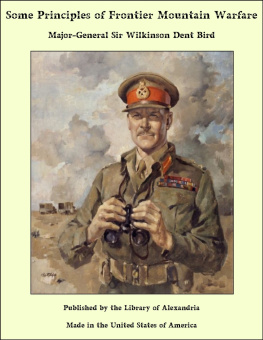| Note: | Images of the original pages are available through Internet Archive. See https://archive.org/details/someprinciplesof00bird |
SOME PRINCIPLES
OF
Frontier Mountain Warfare
BY
BREVET-MAJOR W.D. BIRD, D.S.O.
(Late Professor at Indian Staff College.)
London:
HUGH REES, Ltd. , 119, PALL MALL, S.W.
1909
SOME PRINCIPLES OF FRONTIER MOUNTAIN WARFARE.
The saying that there is no new thing under the sun, is as applicable to military affairs as to those of everyday life, for it is fully admitted that the principles underlying all strategy and tactics, whether of mountain or other warfare, are immutable.
But though the principles of strategy and tactics are unchanging, organisation, formations, and minor items of procedure, must be continually amended to meet ever varying circumstances, and, in addition, each campaign possesses special characteristics demanding further modifications.
There are, in fact, no invariable rules in the conduct of war, and whilst formalism is harmful in all matters, in military operations it is disastrous.
An army relying on an established code of rules will often defeat itself in their application, and even if this disaster is avoided, the enemy will soon become aware of the methods in vogue, and will so frame his tactics as most advantageously to counteract them.
Each problem, great and small, each set of circumstances, must, therefore, be considered on its merits, principles must be applied in the solution, not rules, and strategy, tactics, organisation, equipment, and other matters, arranged accordingly.
It is in this spirit that the problems of Indian Frontier warfare should be approached.
GENERAL CONSIDERATIONS.
The strength and organisation of a force destined to undertake operations against the transborder clans of the Indian frontier is naturally conditioned by the physical features of the area, by its fertility, and by the numbers, character, organisation, and armament of its inhabitants.
It has been truly said that in war every available man should be employed, for one can never be too strong, but this aphorism is always qualified by the number of men that can be fed in the district which is to form the seat of war. The problem of the numbers to be used against the Pathan tribes is, therefore, by no means easy of solution, for, as a great French King said of Spain, in mountainous countries possessing, as does the Indian borderland, few natural resources, but inhabited by a hardy though scanty population, large armies risk starvation, small are in danger of defeat.
The tribesmen of the North West Frontier are brave, and inured to fatigue and hardship, a considerable number have been trained in our Indian army, and these have some knowledge of tactics, and acquaintance with British methods.
The clansmen possess no artillery, but in other respects are fairly well armed, and owing to the cheap sale of rifles and ammunition in Afghanistan, are daily becoming more formidable in this respect. They suffer, however, from two grave military faults, lack of discipline and cohesion, and at present would, it is believed, be unable to mass against any one of several columns invading their fastnesses.
They would, more probably, be content merely to defend their own valleys and homesteads, rather than attempt to defeat, in detail, the divided forces of an invader operating from exterior lines.
It would seem, then, that in a campaign in the Indian borderland, British troops would be justified in undertaking a concentric invasion from several localities.
Certain advantages may also be claimed for this policy.
The road space occupied, in these pathless regions, by a large force moving on one line, is so great, that, as was demonstrated in Sir W. Lockhart's advance from Shinawari, in 1897, the rear of the column will be several days' march behind the leading troops. In these circumstances, not only will risk of defeat in detail be even greater than in the case of concentric invasionfor small columns can better exercise mutual support, than can a large force moving in a restricted valleybut the length of the convoy train, and the seeming strength of the force, will be a direct temptation to the tribesmen to avoid battle, and have recourse to guerilla warfare.
Besides, if small columns are employed, the whole country will be, in the first instance, over-run, and the enemy may, on account of the apparent weakness of the various detachments, take heart of grace and fight.
This, after all, is what is most desired, for the aim is always to attain rapid and decisive victory, and so end the campaign.
An argument against convergent invasion is, that since it may be necessary to use more than one line of communication, not only will the employment of larger numbers be necessary, but more transport animals, the provision and care of which really constitutes the main difficulty in frontier warfare, will be required.
This drawback may, however, be mitigated by opening only one line of communication, along the easiest route, the other detachments moving as flying columns, until the heart of the district is reached, when their surplus animals can be transferred to line of communication duties.
STRENGTH AND ORGANISATION OF COLUMNS.
In deciding the strength of a column for an expedition against the North West Frontier tribesmen, the first requisite, having regard to the foregoing considerations, is so to limit numbers, that, in the topographical conditions likely to be met, the force can, as an entirety, make a march of reasonable length, let us say eight or ten miles. Assuming that the column will move at an average rate of about two miles per hour, that, in order to avoid risk of disaster, it is, as a rule, desirable for the main force not to march before dawn, and to be in camp by dusk, and that tentwelve hours of daylight are available, it is clear that the road space occupied must not, for a ten mile march, exceed ten to fourteen miles. That is to say, the numbers that can fulfil this condition on a narrow track, amount to about 4500 fighting men, carrying three days' rations on the person, and five days' on transport animals.
Suppose that four such columns are destined to invade the Afridi Tirah.
The Afridis are said to possess 25,000 to 30,000 fighting men, and if it be assumed that two-thirds of these have breech loading rifles, and that the whole mass is unlikely to attack any, one, or even two columns, the largest hostile gathering that a British detachment may expect to meet is 6000-8000 men, of whom 4500-5500 may be well armed.
A column of 4500 disciplined troops need not therefore fear reverse.
The composition of a column is regulated by the topography of the area of operations, but the following example will show how the allotment of troops may be determined.
As basis for calculation a mixed brigade organised for independent action may be taken. To these troops may be added a squadron of Silladar cavalry, if the country is suitable to its action, and a mountain battery, which, together with the infantry, form a handy force of the three arms.
But the column is still weak in infantry, on which the brunt of the fighting will necessarily fall, and possesses no technical troops for road-making, etc.
Both requirements may be fulfilled by the addition of a pioneer battalion, or, since some hold that sappers and miners are more economical than pioneers, a battalion, of British infantry, or of Gurkhas, and a company of sappers and miners may be included.
It now only remains to give the troops an ammunition column, the necessary staff, certain additional medical, and administrative details, and the forceone infantry brigade organised for independent action, one squadron, one mountain battery, one British battalion, one company sappers and miners, etc.will be complete, and adequate for its purpose.







